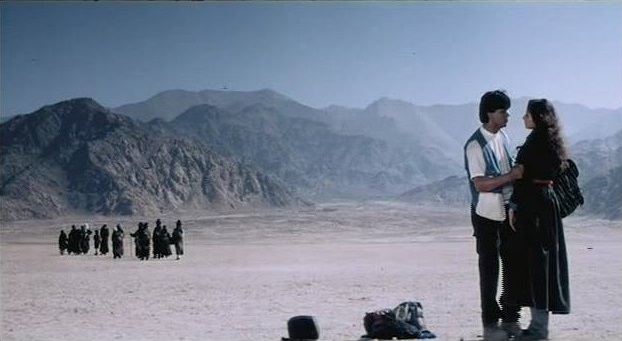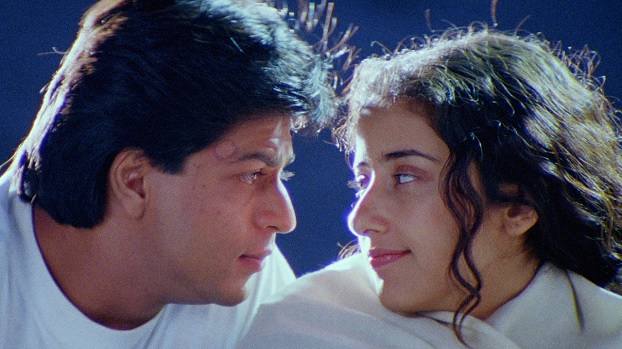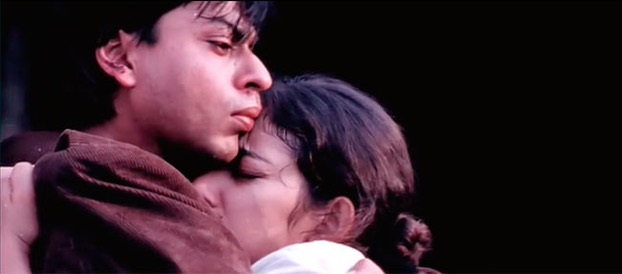Spoiler alert: If you haven’t seen this classic film yet, please note that this post shares details of the plot, including the conclusion.
Growing up in the ’90s watching Bollywood movies in Pakistan, like many people from my generation, our views and opinions around love and relationships were heavily influenced by what we saw in films and desi cinema. Most movies from that era portrayed romantic love in ways that I would grow up to find painfully simplistic and removed from reality.
The biggest obstacles most Bollywood protagonists faced when trying to be with the one they loved, were mostly rooted in issues of class and culture; the girl was from a poor family, while the man was too rich for his own good. Religion was also a challenge to be overcome, as was caste and creed. Then there was the issue of getting parents to agree and approve of the union. Very often the star-crossed lovers would have to elope because the parents (usually the fathers) could not get over one of the handful of issues noted above.
In short, the message most Bollywood movies were sending out about finding a loving and meaningful relationship was this: all love is love at first sight, and it is perfectly acceptable for two people to fall madly, head-over-heels for one another after one, short, superficial conversation. The rules of attraction, courting the other person, building intimacy, showing vulnerability — none of these aspects of pair bonding were ever explored, much less touched upon. Love was all about getting your parents to approve, and then once everyone was okay with it, you got married and the movie ended and the couple lived happily ever after, presumably.
“Most movies from that era portrayed romantic love in ways that I would grow up to find painfully simplistic and removed from reality.”
Today, I’m a married woman in my 30s and I know it takes so much more for two people to fall in love, to stay in love, and to build a life together. The idea that drastic differences in socioeconomic status between two people can all be overcome with love is misleading. Love is messy. Relationships are messy. The people you love will hurt you, and you’ll hurt them.
Love is about so much more than physical attraction (which never culminated in any sort of sexual activity in these movies). Instead of realistic and nuanced views of romance and love, films fed us propaganda about how our parents are the most important thing in our lives, and that “true love” will always prevail, no matter how unlikely a relationship is to succeed in the long run.
It wasn’t until Dil Se.. (From the Heart..) came out in 1998 that I, for the first time in my young life, saw a different side of what it means to love and be loved. The movie is not your typical “boy meets girl, they fall in love and live happily together” narrative. This was a film about trauma, loss, heartbreak and war.
Our “hero” wasn’t the first-born son of a billionaire tycoon who wanted to be a free agent and didn’t care about the fortune he was to inherit from his father. Neither was our “heroine” a shy, sheltered girl from the village who didn’t mind being ruthlessly pursued by a man until she one day decided she loved him (this all normally happened within the span of a few days).
“The movie is not your typical ‘boy meets girl, they fall in love and live happily together’ narrative.”
Moina (or Meghna, we’re never quite told what her real name is) played by Manisha Koirala is the enigmatic female lead who harbours a dark secret — she’s part of a terrorist cell that’s planning a suicide bombing in Delhi. Shah Rukh Khan plays Amar, a program executive for All India Radio whose father was in the army and died in the line of duty.
Amar’s motivations for being a public servant are made clear — he wants to serve his country, just like his father had. He’s a patriot, and he’s not afraid of shining a light on the more inconvenient realities of modern-day India — genocide, civil war, minority rights, and terrorism are all fair game to cover and explore on his radio show.


Amar’s attraction to Moina seems like your clichéd “love at first sight” storyline, but it touches upon something very few movies portrayed well — curiosity. Amar’s intrigued when he meets Moina, and he can’t quite figure out what it is that attracts him to her. He can see there’s an ocean of sadness under her well-maintained, neutral facade. He sees pain and suffering in her eyes, and he wants to somehow help her. After all that he has seen in his line of work, he can tell when a person is hiding something destructive within.
Moina’s story is one of lost innocence and the brutalities of tribal and civil war. She was violently raped as a child, her village plundered and her family killed. Like many children caught in the crossroads of war, she was initiated into a liberationist, terrorist group at a young age and that’s how she survived. The pain and trauma she carries, along with memories of her past and the psychological damage those experiences inflicted on her are all bubbling beneath the surface, and we see glimpses of them in her interactions with Amar.

One of the most powerful scenes in the movie showcases the complexities of getting close to someone who has not dealt with their deep-rooted traumas. In the desert after their bus breaks down, Amar confronts Moina about her using him and not being honest about who she is. He embraces her (against her will) and they have a heated moment of passion, after which Moina has what seems to be a seizure, when memories from her past start to resurface. Amar encourages her to cry and let go of the anguish she’s keeping buried within, but she resists and regains her composure.
This scene alone warrants a whole essay to distill — how Moina’s PTSD kicks in when intimacy and trust issues are brought up, and how Amar rightly identifies (without knowing for sure), that she had something terrible happen to her in the past, and from which she’s not allowed herself to heal. Watching Dil Se.. again this year, I was struck by how deeply emotional this scene, and others like it in the movie were, and how mainstream Bollywood audiences in the 1990s were not ready to confront the difficult realities of life and love (Dil Se.. was a commercial flop when it came out).
“They set up campfire as night-time rolls in, and have a conversation that mirrors what real-world intimacy is actually like.”
Another beautiful and moving scene comes a little while after the interaction in the desert, when Moina and Amar go off on their own. They set up campfire as night-time rolls in, and have a conversation that mirrors what real-world intimacy is actually like. Amar asks Moina questions about her life, what she likes and dislikes, and then answers those questions for himself.
The romantic energy between the two characters in this scene is palpable, and we as the audience can see them falling in love, laying the base for what they (at least Amar) hope will be the foundation to build a relationship on. Prior to Dil Se.., I don’t think I had ever seen such a poignant depiction of intimacy in a Bollywood movie.

When Moina disappears from Amar’s life the next morning, he is visibly upset, and in an effort to move on from her, agrees to an arranged marriage with Preeti (played by Preity Zinta in her Bollywood debut), set up by his family.
While Preeti is funny and charming, open-minded and modern, Amar doesn’t find her quite as intriguing as he did Moina. This again sheds light on how the laws of attraction go beyond what a person looks like. Amar and Preeti are compatible, but they lack the same sort of chemistry Amar experienced with Moina.
Over the course of their short relationship, Amar and Preeti are more like friends than lovers, and the audience can clearly see that Amar’s decision to marry Preeti has more to do with him A) making his family happy, and B) closing the Moina chapter of his life. Love is not a one-size-fits-all affair, a view that wasn’t particularly well-developed in Bollywood movies from that era.
“Love has the ability to create (beauty, life, meaning), but it also has the ability to destroy.”
Love has the ability to create (beauty, life, meaning), but it also has the ability to destroy, and that’s how Moina and Amar’s love story ends when Amar stops Moina from carrying out a suicide bombing at a parade by sacrificing his own life. Amar’s love couldn’t save Moina from the path of self-destruction and hatred she was on.
In the very last scene, just before the bomb that’s strapped to Moina goes off, we see her give in to her feelings, and unfulfilled hopes and dreams, when she, for the first time in the entire movie, embraces Amar back as the two of them get ready to meet their end. Her humanity, her need to love, her desire to be loved, to live a life free from the burdens of her past — she finds all this in Amar’s arms as their doomed tale comes to a tragic close.

Did Amar really love Moina, or did he, in his own way, want to live up to the ideal of a patriotic Indian (like his father) who sacrifices his life for the country? Was Moina’s pain too great to recover from, and was death the only way out from her suffering? Could our protagonists have found a happy ending to their story?
As the credits start rolling and the audience is left grappling with such questions, one thing becomes apparent — in the pantheon of all time classic Bollywood films, Dil Se.. has rightfully earned itself a spot as one of the most thought-provoking, cinematically beautiful, flawlessly acted, and affecting movies ever put to film. And who can forget that haunting score by A.R. Rahman and poetic lyrics by Gulzar, forever emblazoned in our memories by the soulful deliveries of India’s best recording artists — Sukhwinder, Lata Mangeshkar, Udit Narayan, and Sonu Nigam, among others.
I re-watched Dil Se.. with my mother this year, and near the half-point mark of the movie (when the song “Satrangi Re” is playing), my mother stated, “This is an art film, man. This isn’t for mainstream viewers.”
I wholeheartedly agree.
***
Hina Husain is a writer from Toronto, Canada. Her work has appeared in Vice Canada, CBC, Huffington Post, Matador Network, and various Medium publications. Find her on Twitter @HinaTweetsNow.












